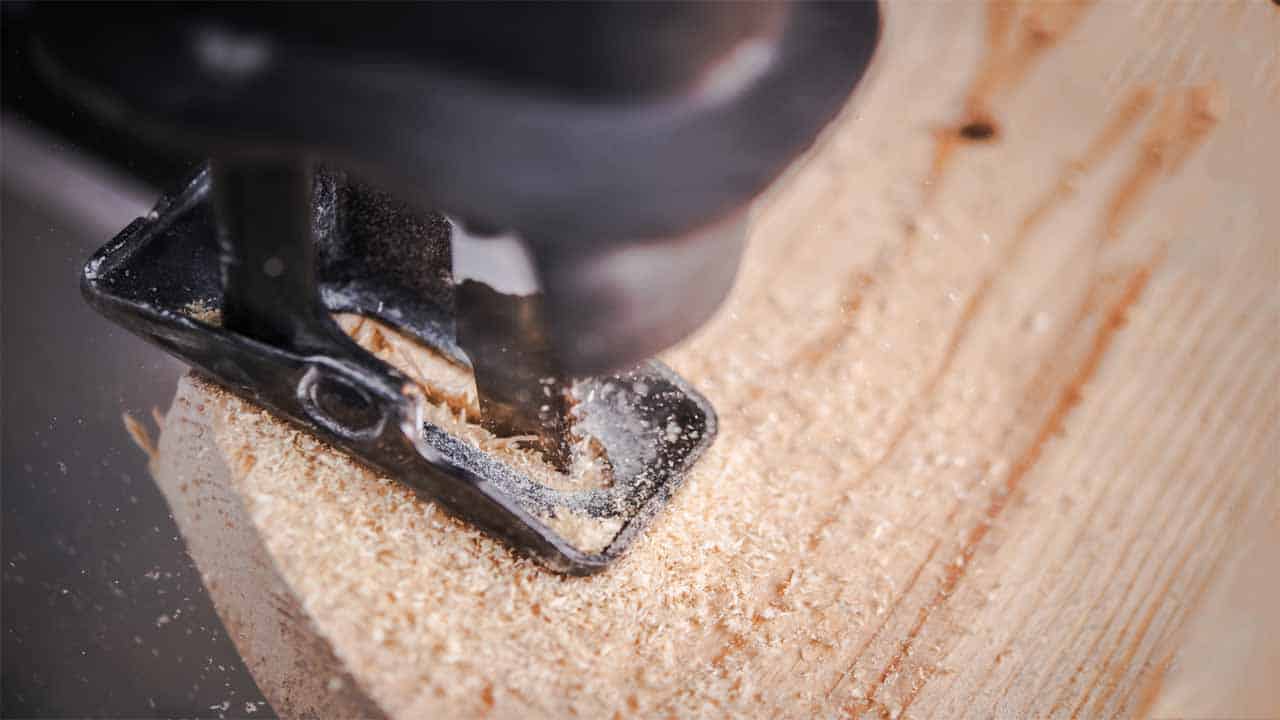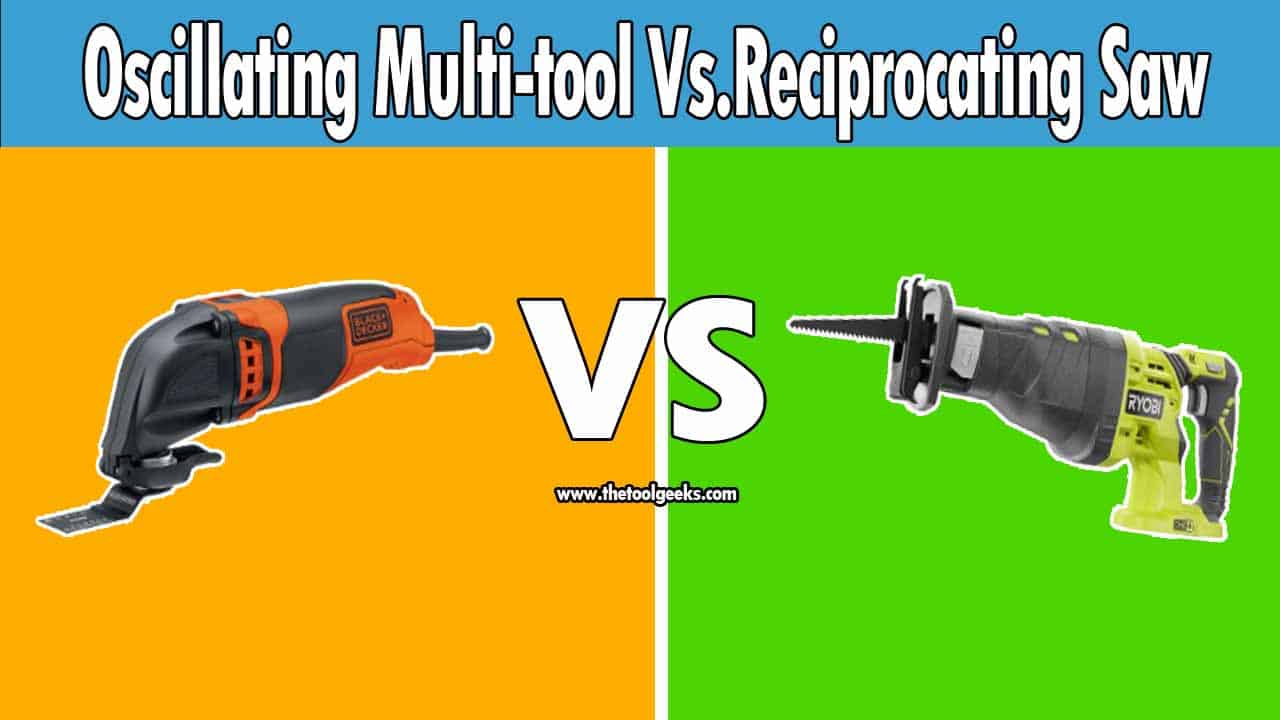Reciprocating Saw Vs. Oscillating Multi-Tool – Similarities & Differences
TheToolGeeks.com is a participant in the Amazon Services LLC Associates Program and other affiliate advertising programs. We may earn from qualifying purchases. (Learn More).
Although reciprocating and oscillating multi-tool saws are used for cutting objects (metal, wooden, or plastic), they differ slightly in features, design, construction, etc. So, to understand the differences and similarities between reciprocating saw vs. oscillating multi-tool, we’ve written a detailed comparison of both in this article.
The importance of both tools at home and in workshops cannot be ignored as both are strong, reliable, and used by professionals and experts in the workshop and DIYers at home.
By the end of this article, you will be well aware of these tools and can decide which one you should choose.
Reciprocating Saw Vs. Oscillating Multi-Tool – Detailed Comparison
1. Construction & Design
The reciprocating saw is a handheld power tool that has a rifle shape. It is a fast-motion tool that works with a push and pull of the blade (made of carbon steel). The blade of this tool is attached to one end. It is a strong, stout tool best for construction purposes. It has a small design so that it can be squeezed into tight spaces.
The oscillating tool features a short blade (or other tools we will discuss later in this article) made of carbide steel and coated with nitrate. It remains in motion sideways at variable speeds allowing cutting, sawing, and many more.
The reciprocating saw has a power source, a fine blade, a blade clamp, a trigger, and a grip, while the oscillating multi-tool has a handle, a power source, and a button.
The similarities in both saws are that they are attached to other tools from the tip to enable a stress-free working session and have a similar structural design.

2. How Do They Both Work?
The reciprocating saw is a go-to remodeling or demolishing tool, and it works by the push-and-pull motion (back and forth) of the blade. Hence, it requires two hands.
On the other hand, in the oscillating saw, the tool or blade vibrates a little (sideways) and requires only one hand to operate.
3. Outcome Results
An oscillating saw is a stable tool that ensures the object on the device does not vibrate much, which can require more time to cut. However, the reciprocating saw needs more effort/two handles to handle it because the blade vibrates and oscillates.
If we talk about the cutting speed, the reciprocating is better because it allows you to control the pressure you put and works like a throttle.
On the other hand, an oscillating saw takes more time to cut the object because of less vibration, making it suitable for precise cuts.
Related Read — How to Cut Straight With a Sawzall?
4. Weight/Portability
The reciprocating saw is quite heavy and bulky, though its heaviness depends on the person operating or using it. For instance, it would be heavier in the hands of someone operating it with one hand than in the hands of someone operating it with both hands.
As for the oscillating multi-tool, it is less heavy and bulky. However, whether or not it would be easy to handle depends on the kind of tool attached to it. Regardless of the tool attached to it, the oscillating multi-tool is best operated with one hand as it provides stability. (it is more portable).
Related Read — Best Battery-Powered Sawzall
5. Applications of Reciprocating Saw & Oscillating Multi-Tool
Reciprocating saw blade makes the tool cut and slice seamlessly and efficiently through wood, plastic, and thin metals like nails.
The reciprocating saws are applied for stronger materials due to their overall aggressive cut-through material (framing windows and doors ). It isn’t easy to use, but being powerful makes it ideal for heavy work. ( it can be used to cut stone, concrete, tiles, or glass).
The oscillating saw is best for more precise cutting, so it can be used for trimming and cutting small objects. The Oscillating multi-tool is preferred and used by most professionals and DIY enthusiasts because of its flexibility and ease to control, especially when operated with one hand.
Which One is More Versatile?
The oscillating multi-tool is most versatile as it has many attachments that allow cutting, sanding, and sawing. This tool is one of the most popular power tools on the market because of its versatility.
The Oscillating multi-tool can be attached to a couple of other driven tools and used to saw, cut, grind, and perform various other activities.
See details about oscillating saw attachments.
6. Durability
Regarding durability, the oscillating saw’s appearance is more brittle and breakable. This small tool has a sensitive construction.
On the other hand, a reciprocating tool is more durable in comparison, as only its blades require replacement. The overall design of reciprocating saws is more durable and long-lasting.
7. Maintenance
Maintenance of both saws is almost the same and easy. None of them needs more attention to maintenance. However, these are the overall things to take care of in both.
- Always keep the LED light indicator in observation as it is an alarm that indicates it’s time to charge the battery.
- Utilize force against friction in full drag.
- Keep the blades of both saws lubricated by applying oil/grease.
- If you do not have a separate space for the saws: disassemble it after every use.
- Let the saw be cooled down before storing it: keep it away from children or pets. ( can cause severe injury).
Related Read — Sawzall vs Hackzall
8. Reciprocating Saw Vs. Oscillating Multi-Tool – Price Comparison
We’ll compare two Dewalt reciprocating and oscillating saws we frequently use for woodworking.
| Saws | Price (Tool Only – No tools and accessories) |
| 20V MAX* XR® Brushless Cordless Reciprocating Saw | $170-$250 (as of 29 March 2023) |
| DEWALT FLEXVOLT ADVANTAGE 20V MAX* Reciprocating Saw | $150-$200 (as of 29 March 2023) |
Oscillating Multi-tool
| Saws | Price (Tool Only – No tools and accessories) |
| DEWALT 20V Max XR Oscillating Multi-Tool | $120-$180 (as of 29 March 2023) |
| DEWALT ATOMIC 20V MAX* Oscillating Tool | $90 (as of 29 March 2023) |
So, It’s clear that oscillating multi-tools are less expensive than reciprocating saws (No tools). Still, if we include other accessories, you may expect different price ranges, as the toolset used with oscillating saws is versatile (different tools). Also, we compared prices of only Dewalt tools, and it’s possible that if you look for saws by other companies, the prices might differ. Generally, you can see from the above tables that oscillating saws are cheaper.
Note: We took these prices from Amazon.
Reciprocating Saw Vs. Oscillating Multi-Tool – Pros & Cons
Everything has benefits and limitations; the case is the same for both saws. In this portion of the article, we will specifically disclose the pros and cons of each saw in their respective heading.
Pros and Cons of the Reciprocating Saw
Pros
- The blades can be found in different shapes and teeth.
- It can cut an object horizontally and vertically.
- It is ideal for construction sites and heavy work.
- Easy maintenance and replacement of blades.
- It has more safety during usage.
Cons
- The tools cannot cut complex angles or shapes.
- The tool is not for precise cuts or clean cutting. It is more of a rough-cutting saw.
- It is a noisy, heavy, and bulkier saw.
Pros and Cons of the Oscillating Saw
Pros
- The saw’s blades (tools) come in different shapes and sizes, allowing the user to perform different tasks: sanding, grinding, scraping, and many more.
- It is a portable saw that allows easy handling and working.
- It is more precisely used for small cuts and shapes from different angles.
- The saw has variability in speed that allows greater control.
- This saw has control over both overloading tools and burned word surfaces.
- The saw is a multi-tool and allows a lot of accessories and attachments.
- It can be battery-powered or cable with minimal dust accumulation (that prevents blades from clogging).
Cons
- The tools are more pricey than reciprocating saws. (because of accessories).
- The blades won’t last long if used for aggressive work.
Conclusion
Overall, if we talk about both saws, both are powerful and flexible. But the oscillating multi-tool is more flexible as it allows more attachments. The reciprocating saw uses a blade to cut through different materials (objects).
In conclusion, if you need powerful and rougher cutting, then a reciprocating saw is best, while for precise cuts and smoother cutting, you will want an oscillating saw.
Faq
Is a reciprocating saw the same as an oscillating tool?
No, the oscillating saw is more of a versatile working saw for uses other than just hacking through the material and it can be used for various tasks. The reciprocating saw is for rough and tough material cutting due to its push-pull motion.
Amazon and the Amazon logo are trademarks of Amazon.com, Inc, or its affiliates.

